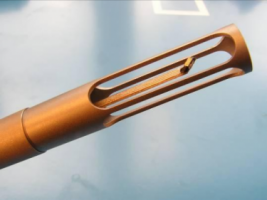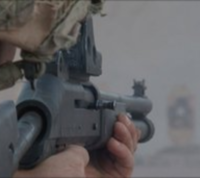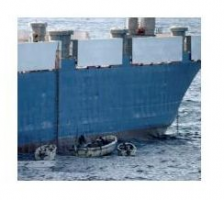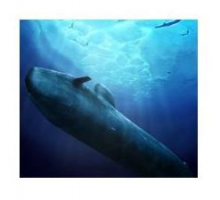
Categories
- Electrical, Electronics & Electro-optics
Microflown AVISA manufactures unique and patented acoustic particle velocity sensors and exports them all over the world. The sensors have properties which make them beneficial for the defence industry, as source (target) locating sensors, enhancing situational awareness.
The particle velocity sensors can be used as extremely compact Acoustic Vector Sensors (AVS), capable of detecting, localising, identifying and tracking sound sources in 3D space. These ‘acoustic radars’ can complement traditional radars as they work in close range and under unfavourable weather conditions such as fog or rain.
AVS can be deployed on a variety of platforms, be it on land, in air or at sea, for the following applications:
- Sniper Detection and Localisation (Ground, vehicle and soldier mounted)
- Artillery Detection and Localisation (Ground, vehicle and soldier mounted)
- Passive ‘Radar’ (Border/perimeter control type application for tracking vehicles and aircraft)
- Battlefield Mapping for UAVs (detection of gunshots and artillery on the ground, sensor steering)
- Sense & Avoid System for UAVs
- Underwater ‘Hydroflown’ for Underwater Situational Awareness
ACOUSTIC VECTOR SENSORS
Microflown's sensors are already established in the automotive industry, but the novel Acoustic Vector Sensors (AVS) are now being used for the detection and localisation of gunshots, artillery, aircraft and vehicles.
Microflown's technology means that passive broad banded acoustic radar systems are now a reality. The benefits as compared to sheer microphone based approaches are obvious, with their small size and weight, and as they can detect a variety of acoustic events from a variety of mounting platforms, a rapid expansion in AVS use for defence and security applications is expected.
At any point in space, a sound field can be described completely by its two dimensions; the scalar value, and the vector value. The scalar value, sound pressure, is well known and well measured. But the other quantity in acoustics, the vector value acoustic particle velocity, only recently became a directly measurable quantity with the invention of the Microflown sensor.
The Microflown sensor is based upon MEMS technology, and uses the temperature difference in the cross section of two extremely sensitive heated wires to determine the acoustic particle velocity.
Assembling a sound pressure transducer and three orthogonally placed Microflown sensors in one single point, a very compact (5x5x5mm) AVS can be produced. The amplitude differences across the Microflown sensors provide the direction and elevation of sound sources. Further algorithms and/or additional vector sensors allow distance to be calculated.
Contact info #1
Contact info #2
Sniper Localisation
OVERVIEW
Developed for the protection of personnel in hostile environments, Microflown’s Sniper Localisation System detects and localises hostile gunfire using compact Acoustic Vector Sensors (AVS). Incoming supersonic projectiles trigger the detection software with both the supersonic shockwave and subsequent muzzle blast being measured. With a single AVS, all of the relevant information including bearing, elevation and range of the shooter are calculated and reported.
The sensors are ground deployable in either mobile or semi-permanent locations. The integrated 3D compass and inertial sensors allow the system to be deployed with minimal set-up time. In a networked configuration, the calculated sniper locations are sent to command & control. In addition, the sensors can also be vehicle mounted for gunshot detection on the move. Vehicle mounted versions include a visual display with audio reporting inside the vehicle.
GROUND/STRUCTURE MOUNTED
The standard sensor for the Microflown Sniper Localisation System can be ground or building mounted, with reporting at either the sensor position, or a central location where the locally processed data is transmitted in a perimeter protection type set-up. It can also be used as a mobile and fast deployable sniper detection when on patrol or during other missions in hostile environments.
VEHICLE MOUNTED
Microflown's Sniper Localisation System can be vehicle mounted. The system allows precious seconds to be saved as vehicle occupants are often unaware they are taking fire until the vehicle is damaged or the occupants are injured. The system is modular, comprising a small sensor mounted on the vehicle, a processing unit and a visual display. When gunshots are detected, the bearing, elevation and distance of the shooter are displayed and spoken (by recorded voice), in real-time, allowing the occupants of the vehicle to return fire immediately.
As the sensors are vector based, background noise from the vehicle itself (engine, tyre/road noise) can easily be ignored with only hostile fire being reported.
SOLDIER WORN
The acoustic vector sensor's small size (5mm3) and light weight (<5g) makes it ideal for mounting on a soldiers combat helmet. An inertial sensor chip inside the helmet allows the detection software to always know how the head is orientated allowing accurate localising and reporting of gunshots.
Different methods of presenting the situational awareness to the soldier are available. An audio channel integrated into the soldiers communication system allows an audio alert for detected gunshots, and information can be visually displayed on:
- PDAs;
- Wrist worn computers;
- Helmet mounted monocles;
- Rifle sights.
Advanced audio processing means that the system will only report aggressive fire and only detect gunshots. Thus no false alarms can be caused by knocks and bangs on the helmet or other nearby noises.
Product informational files
Artillery Localisation
OVERVIEW
Microflown's Artillery Localisation System uses acoustic vector sensors to detect and localise gun breaks and impacts from artillery guns, mortars, tanks, heavy cannons, as well as explosions from mines, bombs and improvised explosive devices (IEDs). With a single sensor unit, bearing and elevation are measured. In a networked configuration, range is also calculated with all parameters being sent to command and control.
As with Microflown Technologies' Sniper Localisation System, the sensors are available as ground sensors or vehicle mounted sensors. The 3D compass and inertial sensors allow minimal set-up time.
These acoustic 'radars' can be complimentary to Weapon Locating Radar (WLR) systems as they work in close range and under unfavourable weather conditions such as fog or rain. They can be used for filling in acoustic gaps, cueing the radar where to look, and confirming the targets acquired by the WLR.
GROUND/STRUCTURE MOUNTED
The standard sensor for the Microflown Artillery Localisation System can be ground or building mounted, with reporting at either the sensor position, or a central location where the locally processed data is transmitted in a perimeter protection type set-up. It can also be used as a mobile and fast deployable artillery detection when on patrol or during other missions in hostile environments.
VEHICLE MOUNTED
Microflown's Artillery Localisation System can be vehicle mounted. The system is modular, comprising a small sensor mounted on the vehicle, a processing unit and a visual display unit. When blasts are detected, the bearing and elevation of the artillery is displayed and spoken (by recorded voice), in real-time, allowing the occupants of the vehicle to take action. In a networked configuration, distance to the artillery localtion will also be provided.
As the sensors are vector based, background noise from the vehicle itself (engine, tyre/road noise) can easily be ignored with only hostile fire being reported.
Product informational files
Passive Radar
OVERVIEW
Microflowns Border/Perimeter Control is a passive radar system using acoustic signals to detect, localise, classify and track aerial and ground vehicles. Multiple sensor units can be installed along the border or perimeter to be protected, with a spacing of around 10km. One or more acoustic vector sensors can detect a threat within a range of 10km (aerial) and around 2km (ground) and relay the information via radio communications to command and control. Within a few seconds the location of the threat and calculated trajectory is displayed to operators. Using the acoustic signature of the source, the threat can be identified as a helicopter, propeller airplane, jet, ground vehicle or boat. The threat data can be integrated into existing command & control systems to supplement a national or local common operating picture.
Advantages of using passive acoustic radar are:
- Passive System (hard to detect)
- Can detect low flying aircraft and ground vehicles where radar cannot
- More cost efective than traditional radar
- Small footprint
- Fast response time
- 360 degrees field of view
- Threat identification, i.e. airplane, helicopter, ground vehicle, boat,etc.
- Can be combined with Microflown Technologies' Sniper Localisation and Artillery Localisation systems to create a full Situational Awareness Suite
GROUND/STRUCTURE MOUNTED
The standard sensor for the Microflown Passive Radar can be ground or building mounted, with reporting at either the sensor position, or a central location where the locally processed data is transmitted in a perimeter protection type set-up. It can also be used as a mobile and fast deployable perimeter protection when on patrol or during other missions in hostile environments.
VEHICLE MOUNTED
Microflown's Passive Radar can also be vehicle mounted. In vehicle mounted versions, aircraft are detected but not vehicles. As the sensors are vector based, background noise from the vehicle itself (engine, tyre/road noise) can be ignored.
Product informational files
Shooting Range Acoustic Scoring System
OVERVIEW
On both direct, and indirect shooting ranges, Microflown Technologies Acoustic Vector Sensors (AVS) can be used to locate the point of impact of both supersonic (e.g. small and large calibre rifles) and subsonic (e.g. mortar rounds) projectiles.
The method of localisation is different for both types of shots but the results are the same; accurate and immediate confirmation of whether the target was hit, or missed. If missed, the Microflown System will indicate a miss distance also.
The system is applicable to pistol and rifle ranges, tank, mortar and other direct and indirect fire artillery ranges, as well as air-to-ground shooting ranges.
DIRECT FIRING RANGE
The same technology used in Microflown's Sniper Localisation System is used to detect supersonic projectiles as they hit, or pass near to, targets. With just two Acoustic Vector Sensors (AVS) positioned next to the target, the system can calculate the position of the projectile and compare this against the known target position. The shooter's 'score' is displayed on a score computer, and can be saved for further analysis and statistics.
Microflown's Shooting Range Acoustic Scoring System can be used for all supersonic projectiles fired on pistol and rifle ranges, tank and other direct fire artillery ranges and air-to-ground shooting ranges.
INDIRECT FIRING RANGE
For weapons training with indirectly fired projectiles such as mortars, or indeed missiles and bombs released from aircraft, separate AVS nodes are distributed around the firing range. The sensors are networked together to provide the locations of impact, covering a large area with just a few sensors.
Noise Canceling Headset Microflown
OVERVIEW
The unique properties of the Microflown sensors allow the reproduction of sound from a single direction, while noise from all other directions is rejected. In a headset application this means that communication in noisy battlefield or vehicular environments can be transmitted clearly and intelligibly, with no need for further processing the signal. The Microflown sensor, replacing a standard microphone, is directed towards the mouth of the operator, hence only speech will be reproduced.
Traditional signal processing attempts to remove unwanted noise from the contaminated signal after transduction, so there is always a compromise in noise reduction, to make sure the desired signal remains clear. Now, with the Microflown sensor, the noise is removed before transduction, so the audio signal is clear and intelligible from the start.
Battlefield Mapping
OVERVIEW
Due to their light weight and compact size, acoustic vector sensors can be incorporated in even the smallest UAV for the purpose of intelligence, surveillance and reconnaissance, capable of detecting acoustic events and steering the UAVs other sensors. The acoustic vector sensors have the ability to detect gunshots and artillery on the ground, and even tell whether the gunshots are aimed at the UAV or not, all despite the presence of both wind and the UAV's own self-generated engine noise.
Sense & Avoid
OVERVIEW
Aside from the detection of ground based acoustic events, acoustic vector sensors can be used as a mid-air anti-collision system, detecting any flying objects approaching (a UAV for example) from any direction, so long as they make noise of course. Using novel signal processing techniques, a large number of sound sources around the unmanned aerial vehicle can be simultanously localised, and if necessary, can be avoided.
In principle the system is currently being developed for UAVs but it is equally applicable to larger aircraft and also unmanned ground vehicles (UGVs)and autonomous underwater vessels (AUVs).
Product informational files
Precision Airdrop System
OVERVIEW
Acoustic vector sensors can be of help in improving both soft and precise landing of precision airdrop systems. Over the years, sheer sound pressure based systems have been developed to measure both the height and speed of an airdrop system to ensure a soft landing. Acoustic height transducers that are collocated with a sound source generating an impulse type of noise can detect the acoustic reflection from the ground. ( click here to read more ). Acoustic detection systems are not susceptible to clouds, dust and fog. Furthermore they are able to detect the air-ground interface in cases where other sensors don’t, for instance at an earth surface covered with dense foliage / vegetation or (reflecting) snow. Acoustic vector sensors improve this functionality, as they can be used to measure both the acoustic absorption of the earth surface and the flatness of the designated landing area. Acoustic vector sensors measure the acoustic reflections from all sides, so both earth and (when applicable) mountains. If the airdrop system is somehow approaching an area that is not flat, the surrounding mountains will also reflect acoustically. This signal will be picked up by the AVS as an indication the airdrop system is approaching dangerous areas. Also the precision of an airdrop can be improved using acoustic vector sensors. If GPS landing coordinates are not available or change during the dropping, the AVS can steer the airdrop system towards its designated receiver on the ground. As they are directional, the acoustic vector sensors can detect for instance a low frequency and thus inaudible) noise signal emitted by the receiving party, thus acting as a last resort homing in procedure. Acoustic vector sensors improve the functionality making them a valuable part of the sensor kit on board of the airdrop system.
Helicopter Landing Assistance System
OVERVIEW
Microflown's Acoustic Vector Sensors (AVS) can be used to help helicopters land in environments with impaired visibility (e.g. brown-out, desert landing, or white-out, snow or fog landing), and with vertically moving landing areas such as sea vessels.
There are three ways in which AVS can assist landings:
Ground based acoustic detection to home in the helicopter
At a given landing area, AVS can be installed. Considering the helicopter as a single tonal sound source, the position of the helicopter (bearing, elevation, and range) can be determined and relayed to the pilot.
Airborne AVS detecting acoustic ground beacon
AVS can detect a beacon on the ground, despite the tonal background noise of the helicopter and the wind noise around the sensor
Helicopter's own low frequency noise transmission is used
If the helicopter is seen as a noise source, its reflection on the ground can be used to aid navigation. Approaching the ground, acoustic reflection takes place, causing standing waves to occur. Exploiting this phenomenon, the helicopter can navigate in a similar fashion to a bat.
Product informational files
Moving Platform Landing System
OVERVIEW
It can be difficult to safely land UAVs on to moving platforms such as sea vessels, which have both lateral and horizontal displacement. Using a Microflown Acoustic Vector Sensor (AVS) on the UAV, and a radio controlled beacon on the landing platform, the UAV can be guided into land with both relative bearing and elevation information being provided to the UAV.
Coast Protection
OVERVIEW
Microflown Technologies Passive Radar can be used to protect coast lines, with several sensor stations networked together to create an acoustically tight perimeter. The passive radar can be used to detect, for example, low flying aircraft, small boats and other sea vessels. When mounted on buoys, the detection range can be increased further out to sea for the detection of sea skimming missiles.
The Passive Radar for Coastal Protection can be used to complement existing radar or even to replace it, where traditional radar isn't feasible.
Sea Vessel Perimeter Protection
OVERVIEW
The Passive Radar technology incorporating acoustic vector sensors can be used to detect and localise other sea vessels and aircraft approaching the protected sea vessel. As with the coastal protection application, the passive radar can be used in conjunction with the existing on-board radar or can replace it under unfavourable conditions which can create clutter, such as fog, rain, large sea waves, etc.
Mine Blast Detection
OVERVIEW
Unmanned seagoing vessels are used to clear waterways and harbors from sea mines, sensors replacing human sensing capabilities. Obviously it is of utmost importance to know as accurately as possible the position of a mine blast. As acoustic vector sensors are directional, they can point at the position where the exploding mine blast reached the surface. Unlike most other types of sensors, acoustic vector sensors also work in case of rain or fog.
Hydroflown
OVERVIEW
The Microflown sensor can also be placed underwater - the so called Hydroflown. The sensor is immersed in a non-conductive fluid contained within a special sealed housing to isolate it from sea water. As the 3D Acoustic Vector Sensor can also be placed underwater, this opens up many underwater situational awareness applications. Localising surface vessels, underwater vessels and torpedoes should be possible. Submarine and unmanned underwater vehicles applications are also likely.
The first phase of the Hydroflown project is a Eurostars funded project with the NATO Underwater Research Centre La Spezia as partner.
Microflown AVISA
- Tivolilaan 205, 6824 BV, Arnhem, The Netherlands
- www.microflown-avisa.com/


















